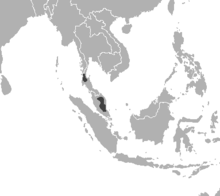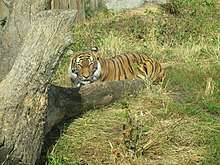Malayan tiger
The Malayan tiger is a tiger from a specific population of the Panthera tigris tigris subspecies that is native to Peninsular Malaysia.[5] This population inhabits the southern and central parts of the Malay Peninsula, and has been classified as Critically Endangered on the IUCN Red List in 2015. The population was roughly estimated at 250 to 340 adult individuals in 2013, and likely comprises less than 200 mature breeding individuals and has a declining trend.[1]
| Malayan tiger | |
|---|---|
 | |
| A Malayan tiger in Cincinnati Zoo | |
| Scientific classification | |
| Kingdom: | Animalia |
| Phylum: | Chordata |
| Class: | Mammalia |
| Order: | Carnivora |
| Suborder: | Feliformia |
| Family: | Felidae |
| Subfamily: | Pantherinae |
| Genus: | Panthera |
| Species: | |
| Subspecies: | P. t. tigris |
| Trinomial name | |
| Panthera tigris tigris | |
 | |
| Range of the Malayan tiger | |
| Synonyms | |
|
formerly: | |
In the Malay language, the tiger is called harimau, also abbreviated to rimau.[6] It is also known as the southern Indochinese tiger, to distinguish it from tiger populations in northern parts of Indochina, which are genetically different to this population.[2]
Taxonomy
Felis tigris was the scientific name used by Carl Linnaeus in 1758 for the tiger.[7] Panthera tigris corbetti was proposed by Vratislav Mazák in 1968 for the tiger subspecies in Southeast Asia.[8][9] Panthera tigris jacksoni was proposed in 2004 as a subspecies as a genetic analysis indicated differences in mtDNA and micro-satellite sequences to P. t. corbetti.[2]
Since revision of felid taxonomy in 2017, the Malayan tiger is recognised as a P. t. tigris population.[5] However, a genetic study published in 2018 supported six monophyletic clades based on whole-genome sequencing analysis of 32 specimens. The Malayan tiger appeared to be distinct from other mainland Asian tiger specimens, thus supporting the concept of six subspecies.[10]
Naming
When the tiger population of the Malay Peninsula was accepted as a distinct subspecies in 2004, the chairman of the Malaysian Association of Zoos, Parks and Aquaria argued that the new subspecies should be named Panthera tigris malayensis to reflect the geographical region of its range.[11] As a compromise, it received the vernacular name "Malayan tiger", and the scientific name jacksoni, which honours the tiger conservationist Peter Jackson.[12][13] Nevertheless, P. t. malayensis was used by other authors.[3][4]
Characteristics

There is no clear difference between the Malayan and the Indochinese tigers, when specimens from the two regions are compared cranially or in pelage. No type specimen was designated.[14]
Malayan tigers appear to be smaller than Bengal tigers. From measurements of 11 males and 8 females, the average length of a male is 8 ft 6 in (259 cm), and of a female 7 ft 10 in (239 cm).[15] Body length of 16 female tigers in the State of Terengganu ranged from 70 to 103 in (180 to 260 cm) and averaged 80.1 in (203 cm). Their height ranged from 23 to 41 in (58 to 104 cm), and their body weight from 52 to 195 lb (24 to 88 kg). Data from 21 males in the State of Terengganu showed that total length ranged from 75 to 112 in (190 to 280 cm), with an average of 94.2 in (239 cm). Their height ranged from 24 to 45 in (61 to 114 cm), and their body weight from 104 to 284.7 lb (47.2 to 129.1 kg).[9]
Distribution and habitat
The geographic division between Malayan and Indochinese tigers is unclear as tiger populations in northern Malaysia are contiguous with those in southern Thailand.[1] In Singapore tigers were extirpated in the 1950s, and the last one shot in 1932.[9]
Between 1991 and 2003, tiger signs were reported from early-succession vegetation fields, agricultural areas outside forests in Kelantan, Terengganu, Pahang, and Johor, and many riparian habitats outside forests in Pahang, Perak, Kelantan, Terengganu, and Johor. Most of the major rivers that drain into the South China Sea had some evidence of tigers, whereas those draining into the Straits of Malacca in the west did not.[16]
Tiger signs were not reported from Perlis, Penang, and Malacca, and the federal territories of Kuala Lumpur and Putrajaya in the west coast. The total potential tiger habitat was 66,211 km2 (25,564 sq mi), which comprised 37,674 km2 (14,546 sq mi) of confirmed tiger habitat, 11,655 km2 (4,500 sq mi) of expected tiger habitat and 16,882 km2 (6,518 sq mi) of possible tiger habitat. All the protected areas greater than 402 km2 (155 sq mi) in size had tigers.[16]
In September 2014 two conservation organisations announced that a camera trap survey of seven sites in the three separate habitats from 2010 to 2013 had produced an estimate of the surviving population from 250 to 340 healthy individuals, with a few additional isolated small pockets probable. According to the report, the decline meant that the species might have to be moved to the "Critically Endangered" category in the IUCN list.[17] As of 2019, due to poaching and the depletion of prey, the number of tigers in Belum-Temengor Forest Reserve has declined about 60% over a period of 7–8 years, from approximately 60 to 23.[18][19][20]
Ecology and behaviour
Malayan tigers prey on sambar deer, barking deer, wild boar, Bornean bearded pigs and serow. Malayan tigers also prey on sun bears,[21] young elephants and rhino calves. Whether their principal prey includes adult gaur and tapir is unknown. Occasionally, livestock is also taken; however, tiger predation reduces the numbers of wild boar which can become a serious pest in plantations and other croplands. Studies indicate that in areas where large predators (tigers and leopards) are extinct, wild pigs are over 10 times more numerous than in areas where tigers and leopards are still present.[22][23][24]
Tigers occur at very low densities 1.1–1.98 tigers per 100 km2 (39 sq mi) in the rainforest as a result of low prey densities, thus to maintain viable tiger populations of minimum of 6 breeding females, reserves need to be larger than 1,000 km2 (390 sq mi). Information on dietary preference, morphological measurements, demographic parameters, social structure, communication, home range sizes, dispersal capabilities are all lacking.
Threats
Habitat fragmentation due to development projects and agriculture is a serious threat.[16] Between 1988 and 2012, an area of about 13,500 km2 (5,200 sq mi) natural forest was lost in Peninsular Malaysia. Nearly 64,800 km2 (25,000 sq mi) was converted to large-scale industrial plantations, primarily for palm oil production. An area of around 8,300 km2 (3,200 sq mi) constituted prime tiger habitat.[25]
Commercial poaching occurs at varying levels in all tiger range states. In Malaysia there is a substantial domestic market in recent years for tiger meat and manufactured tiger bone medicines.[26]
Between 2001 and 2012, body parts from at least 100 tigers were confiscated in Malaysia. In 2008, police found 19 frozen tiger cubs in a zoo. In 2012, skins and bones of 22 tigers were seized.[27]
The demand for tiger body parts used in Chinese traditional medicine apparently also attracts poachers from Vietnam, Thailand and Cambodia. Between 2014 and 2019, anti-poaching units removed around 1,400 snares from protected areas.[18][19][20]
In 2020, amidst the COVID-19 pandemic, a Malayan tiger in the Bronx Zoo tested positive for the virus.[28]
Conservation

Tigers are included on CITES Appendix I, banning international trade. All tiger range states and countries with consumer markets have banned domestic trade as well.[26]
The Malaysian Conservation Alliance for Tigers (MYCAT) is "an alliance of non-governmental organisations comprising the Malaysian Nature Society (MNS), Traffic Southeast Asia, Wildlife Conservation Society-Malaysia Programme and WWF-Malaysia."[29] It also includes the Department of Wildlife and National Parks.[30]
In 2007, they implemented a hotline to report tiger-related crimes, such as poaching.[31] In order to deter poaching, they organize "Cat Walks", a citizen patrol in danger zones.[32] MYCAT has a goal of increasing the tiger population.[33]
In captivity

The Cincinnati Zoo was the first zoo in North America to begin a captive breeding program for Malayan tigers with the importation of a male and three females from Asia between 1990 and 1992. The breeding program was as a Tiger SSP in 1998. There are also a few Malayan Tigers in Zoo Johor, Zoo Negara Kuala Lumpur and Zoo Taiping and Night Safari. As of 2011 there were 54 of this subspecies in North American zoos. The 54 individuals are located in 25 institutions and are descended from only 11 founders. Therefore, the plan of retaining a target of 90% genetic diversity over the next century is not possible unless other founders are added.
Cultural references
The Malayan tiger is the national animal of Malaysia.[34]
Two tigers are depicted as supporters in the coat of arms of Malaysia, coat of arms of Johor and in the coat of arms of Singapore. The tiger appears in various heraldry of Malaysian institutions such as Royal Malaysia Police, Maybank, Proton and Football Association of Malaysia. It symbolises bravery and strength to Malaysians. It is also the nickname for the Malaysian national football team. The tiger has been given various nicknames by Malaysians, notably "Pak Belang," which literally means "Uncle Stripes." Pak Belang features prominently in folklore as one of the adversaries of Sang Kancil (the mouse deer). The Malayan tiger was featured on Special Service Group insignia and Royal Malay Regiment insignia.
In Emilio Salgari's cycle of novels on the 19th century fictional pirate Sandokan, the protagonist is known as "The Tiger of Malaysia".[35]
See also
- Tiger populations: Bengal tiger · Siberian tiger · Caspian tiger · Indochinese tiger · South Chinese tiger · Malayan tiger · Sumatran tiger · Javan tiger · Bali tiger
- Prehistoric tigers: Panthera tigris soloensis · Panthera tigris trinilensis · Panthera tigris acutidens
References
- Kawanishi, K. (2015). "Panthera tigris subsp. jacksoni". IUCN Red List of Threatened Species. 2015: e.T136893A50665029.
- Luo, S.-J.; Kim, J.-H.; Johnson, W. E.; van der Walt, J.; Martenson, J.; Yuhki, N.; Miquelle, D. G.; Uphyrkina, O.; Goodrich, J. M.; Quigley, H. B.; Tilson, R.; Brady, G.; Martelli, P.; Subramaniam, V.; McDougal, C.; Hean, S.; Huang, S.-Q.; Pan, W.; Karanth, U. K.; Sunquist, M.; Smith, J. L. D.; O'Brien, S. J. (2004). "Phylogeography and genetic ancestry of tigers (Panthera tigris)". PLoS Biology. 2 (12): e442. doi:10.1371/journal.pbio.0020442. PMC 534810. PMID 15583716.
- Schirmer, E. M. (2012). "4: When There Were Tigers In Singapore". When There were Tigers in Singapore: A family saga of the Japanese occupation. Singapore: Marshall Cavendish International Asia Pte Ltd. p. 50. ISBN 9-8144-0884-0.
- Jaafar, H. Z. E. & Ashraf, M. A. (2017). "1: Climate, Ecosystem, Flora, and Fauna". In Ashraf, M. A.; Othman, R. & Ishak, C. F. (eds.). Soils of Malaysia. CRC Press. ISBN 978-1-3519-9857-4.
- Kitchener, A. C.; Breitenmoser-Würsten, C.; Eizirik, E.; Gentry, A.; Werdelin, L.; Wilting, A.; Yamaguchi, N.; Abramov, A. V.; Christiansen, P.; Driscoll, C.; Duckworth, J. W.; Johnson, W.; Luo, S.-J.; Meijaard, E.; O’Donoghue, P.; Sanderson, J.; Seymour, K.; Bruford, M.; Groves, C.; Hoffmann, M.; Nowell, K.; Timmons, Z.; Tobe, S. (2017). "A revised taxonomy of the Felidae: The final report of the Cat Classification Task Force of the IUCN Cat Specialist Group" (PDF). Cat News. Special Issue 11: 66–68.
- Wilkinson, R. J. (1901). A Malay-English dictionary. Hongkong, Shanghai and Yokohama: Kelly & Walsh Limited.
- Linnaeus, C. (1758). "Felis tigris". Caroli Linnæi Systema naturæ per regna tria naturæ, secundum classes, ordines, genera, species, cum characteribus, differentiis, synonymis, locis. Tomus I (decima, reformata ed.). Holmiae: Laurentius Salvius. p. 41.
- Mazák, V. (1968). "Nouvelle sous-espèce de tigre provenant de l'Asie du sud-est". Mammalia. 32 (1): 104−112. doi:10.1515/mamm.1968.32.1.104.
- Khan, M.K.M. (1986). "Tigers in Malaysia". The Journal of Wildlife and Parks. V: 1–23.
- Liu, Y.-C.; Sun, X.; Driscoll, C.; Miquelle, D. G.; Xu, X.; Martelli, P.; Uphyrkina, O.; Smith, J. L. D.; O’Brien, S. J.; Luo, S.-J. (2018). "Genome-wide evolutionary analysis of natural history and adaptation in the world's tigers". Current Biology. 28 (23): 3840–3849. doi:10.1016/j.cub.2018.09.019. PMID 30482605.
- Peng, L. Y. (2004). "Research team: Malayan tiger a new subspecies". The Star Online. Malacca. Retrieved 2019-08-10.
- O’Brien, S. J.; Luo, S.-J.; Kim, J.-H.; Johnson, W. E. (2005). "Molecular Genetic Analysis Reveals Six Living Subspecies of Tiger Panthera tigris". 42. Cat News: 6−8. Cite journal requires
|journal=(help) - McMullin, A. (2005). "IUCN tiger specialist Peter Jackson earns his stripes". International Union for Conservation of Nature, Gland.
- Mazák, J. H.; Groves, C. P. (2006). "A taxonomic revision of the tigers (Panthera tigris)" (PDF). Mammalian Biology. 71 (5): 268–287. doi:10.1016/j.mambio.2006.02.007. Archived from the original on 2013-03-13.CS1 maint: BOT: original-url status unknown (link)
- Locke, A. (1956). The tigers of Terengganu. London: Museum Press Ltd.
- Kawanishi, K.; Yatim, S. H.; Abu Hashim, A. K.; Topani, R. (2003). "Distribution and potential population size of the tiger in Peninsular Malaysia". Journal of Wildlife Parks (Malaysia). 21: 29–50. Archived from the original on 2012-04-06.
- Hance, J. (2014). "Malayan tiger population plunges to just 250-340 individuals". Mongabay.
- "Poachers, limited prey push Malayan tiger to brink of extinction". Bernama. Kuala Lumpur: Free Malaysia Today. 2019. Retrieved 2019-08-10.
- Yahaya, A. M. (2019-07-30). "Poachers and limited prey driving Malayan Tiger to extinction". The Star Online. Kuala Lumpur. Retrieved 2019-08-10.
- Arif, Z. M. (2019-08-03). "Malayan tiger teetering on the brink of extinction; 23 left in Belum-Temenggor Forest Reserve". New Straits Times. Gerik. Retrieved 2019-08-10.
- Kawanishi, K.; Sunquist, M. E. (2004). "Conservation status of tigers in a primary rainforest of Peninsular Malaysia". Biological Conservation. 120: 329–344. doi:10.1016/j.biocon.2004.03.005.
- Yong, D. L.; Lee, P. Y.-H.; Ang, A.; Tan, K. H. (2010). "The status on Singapore island of the Eurasian wild pig Sus scrofa (Mammalia: Suidae)" (PDF). Nature in Singapore. 3: 227–237.
- Ickes, K.; Paciorek, C. J.; Thomas. S. C. (2005). "Impacts of nest construction by native pigs (Sus scrofa) on lowland Malaysian rain forest saplings" (PDF). Ecology. 86 (6): 1540–1547. doi:10.1890/04-0867. JSTOR 3450779. Archived from the original (PDF) on 2011-07-20. Retrieved 2010-10-03.
- Ickes, K. (2001). "Hyper-abundance of native wild pigs (Sus scrofa) in a lowland dipterocarp rain forest of Peninsular Malaysia". Biotropica. 33 (4): 682–690. doi:10.1646/0006-3606(2001)033[0682:haonwp]2.0.co;2. JSTOR 3593170.
- Shevade, V.S.; Potapov, P.V.; Harris, N.L. & Loboda, T.V. (2017). "Expansion of industrial plantations continues to threaten Malayan tiger habitat". Remote Sensing. 9 (7): 747. doi:10.3390/rs9070747.
- Nowell, K. (2007). Asian big cat conservation and trade control in selected range States: evaluating implementation and effectiveness of CITES Recommendations (PDF). Cambridge, UK: Traffic International.
- Shepherd, C. R. S.; Khan, S.; Krishnasamy, K. (2013). "Largest Tiger seizure ever in Malaysia". Cat News (59): 11.
- "Tiger at US zoo tests positive for coronavirus". BBC News. 2020-04-06. Retrieved 2020-04-06.
- Shahar, F. M. (2013). "Take action with Maybank Wild Tiger Run". New Straits Times. Archived from the original on 2014-10-25. Retrieved 2014-09-18.
- Sundararaj, A. (2013). "Tigers, our heritage". New Straits Times. Archived from the original on 2014-10-25. Retrieved 2014-09-18.
- "Tiger hotline gets good response from public". The Star. 2007. Archived from the original on 2017-07-30. Retrieved 2014-09-18.
- Heing, N. (2013). "Nature lovers trail after poachers in bid to deter illegal hunting". The Star. Archived from the original on 2016-03-15. Retrieved 2014-09-18.
- Lee, P. (2014). "Malayan tiger now critically endangered, numbering as few as 250". The Star. Retrieved 2014-09-18.
- DiPiazza, F. (2006). Malaysia in Pictures. Twenty-First Century Books. ISBN 978-0-8225-2674-2.
- Adami, S. (2006). "Emilio Salgari (1862–1911)". In Marrone, G.; Puppa, P. (eds.). Encyclopedia of Italian Literary Studies. New York, London: Routledge. pp. 1654–1655.
External links
| Wikispecies has information related to Panthera tigris jacksoni |
| Wikimedia Commons has media related to Panthera tigris jacksoni. |
- "Tiger Malayan tiger (P. t. jacksoni)". IUCN/SSC Cat Specialist Group.
- "Tiger Projects Malaysia". 21st Century Tiger (Archive). Archived from the original on 2015-06-08.
- "Malayan tiger". WWF. 2010. Archived from the original on 2010-02-16.
- "Malaysian Indochinese tiger at Kuala Lumpur Zoo".

